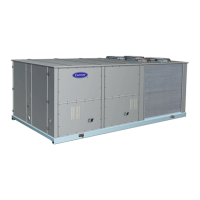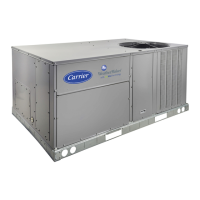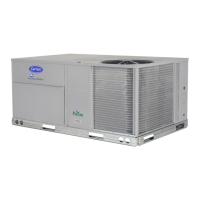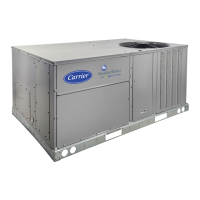77
TEMPERATURE COMPENSATED START LOGIC
The following conditions must be met:
• Unit is in unoccupied state.
• Next occupied time is valid.
• Current time of day is valid.
• Valid space temperature reading is available (sensor or
DAV-Linkage).
The algorithm will calculate a Start Bias time in minutes using
the following equations:
If (space temperature > occupied cooling setpoint)
Start Bias Time = (space temperature – occupied cooling
setpoint)* TCS.C
If (space temperature < occupied heating setpoint)
Start Bias Time = (occupied heating setpoint – space tem-
perature)*TCS.H
When the Start Bias Time is greater than zero the algorithm will
subtract it from the next occupied time to calculate the new start
time. When the new start time is reached, the Temperature Com-
pensated Start mode is set (Operating Modes
MODE
T.C. ST), the fan is started and unit controlled as in an occupied
state. Once set, Temperature Compensated mode will stay on until
the unit goes into the Occupied mode. The Start Bias Time will be
written into the CCN Linkage Equipment Table if the unit is con-
trolled in DAV mode. If the Unoccupied Economizer Free Cool
mode is active (Operating Modes
HVAC = “UNOCC FREE
COOL”) when temperature compensated start begins, the Unoc-
cupied Free Cool mode will be stopped.
Carrier Comfort Network (CCN) System
It is possible to configure the ComfortLink
®
control to partici-
pate as an element of the Carrier Comfort Network (CCN) sys-
tem directly from the local display. This section will deal with
explaining the various programmable options which are found
under the CCN sub-menu in the Configuration mode.
The major configurations for CCN programming are located in
the local displays at Configuration
CCN. See Table 70.
CCN Address (CCNA)
This configuration is the CCN address the rooftop is assigned.
CCN Bus Number (CCNB)
This configuration is the CCN bus the rooftop is assigned.
CCN Baud Rate (BAUD)
This configuration is the CCN baud rate. For units equipped with
the optional UPC, the CCN Baud Rate must be set to 9600.
CCN Time/Date Broadcast (TM.DT)
If this configuration is set to ON, the control will periodically
send the time and date out onto the CCN bus once a minute. If
this device is on a CCN network then it will be important to
make sure that only one device on the bus has this configura-
tion set to ON. If more than one time broadcaster is present,
problems with the time will occur.
NOTE: Only the time and date broadcaster can perform daylight
savings time adjustments. Even if the rooftop is stand alone, the
user may want to set this to ON to accomplish the daylight/savings
function.
CCN OAT Broadcast (OAT.B)
If this configuration is set to ON, the control will periodically
broadcast its outside-air temperature at a rate of once every
30 minutes.
CCN OARH Broadcast (ORH.B)
If this configuration is set to ON, the control will periodically
broadcast its outside air relative humidity at a rate of once every
30 minutes.
CCN OAQ Broadcast (OAQ.B)
If this configuration is set to ON, the control will periodically
broadcast its outside air quality reading at a rate of once every
30 minutes.
Global Schedule Broadcast (G.S.B)
If this configuration is set to ON and the schedule number
(SCH.N) is between 65 and 99, then the control will broadcast
the internal time schedule once every 2 minutes.
CCN Broadcast Acknowledger (B.ACK)
If this configuration is set to ON, then when any broadcasting is
done on the bus, this device will respond to and acknowledge.
Only one device per bus can be configured for this option.
Schedule Number (SCH.N)
This configuration determines what schedule the control may
follow.
SCH.N = 0 The control is always occupied.
SCH.N = 1 The control follows its internal time schedules.
The user may enter any number between 1
and 64 but it will be overwritten to “1” by the
control as it only has one internal schedule.
SCH.N = 65-99The control is either set up to receive to a
broadcasted time schedule set to this number
or the control is set up to broadcast its inter-
nal time schedule (G.S.B) to the network and
this is the global schedule number it is broad-
casting. If this is the case, then the control
still follows its internal time schedules.
Table 70 — CCN Configuration
* For units equipped with optional UPC, the CCN Baud Rate must be set to 3.
ITEM EXPANSION RANGE UNITS POINT DEFAULT
CCN CCN CONFIGURATION
CCNA CCN Address 1 to 239 CCNADD 1
CCNB CCN Bus Number 0 to 239 CCNBUS 0
BAUD CCN Baud Rate 1 to 5 CCNBAUDD 3*
BROD CCN BROADCST DEFINITIONS
TM.DT CCN Time/Date Broadcast ON/OFF CCNBC On
OAT.B CCN OAT Broadcast ON/OFF OATBC Off
ORH.B CCN OARH Broadcast ON/OFF OARHBC Off
OAQ.B CCN OAQ Broadcast ON/OFF OAQBC Off
G.S.B Global Schedule Broadcst ON/OFF GSBC Off
B.ACK CCN Broadcast Ack'er ON/OFF CCNBCACK Off
SC.OV CCN SCHEDULES-OVERRIDES
SCH.N Schedule Number 0 to 99 SCHEDNUM 1
HOL.T Accept Global Holidays? YES/NO HOLIDAYT No
O.T.L Override Time Limit 0 to 4 HRS OTL 1
OV.EX Timed Override Hours 0 to 4 HRS OVR_EXT 0
SPT.O SPT Override Enabled ? YES/NO SPT_OVER Yes
T58.O T58 Override Enabled ? YES/NO T58_OVER Yes
GL.OV Global Sched. Override ? YES/NO GLBLOVER No

